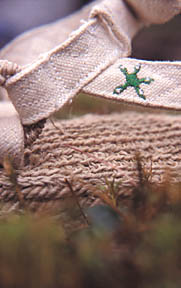 |
All
Natural Footwear, Knitwear, and Special Gifts
|
 |
|
The
Real Hemp Facts
|
| HISTORICAL
FACTS *Hemp has been grown for at least the last 12,000 years for fiber (textiles and paper) and food. It has been effectively prohibited in the United States since the 1950s. *George Washington and Thomas Jefferson both grew hemp. Ben Franklin owned a mill that made hemp paper. Jefferson drafted the Declaration of Independence on hemp paper. *When US sources of "Manila hemp" (not true hemp) were cut off by the Japanese in WWII, the US Army and US Department of Agriculture promoted the "Hemp for Victory" campaign to grow hemp in the US. *Because of its importance for sails (the word "canvas" is rooted in "cannabis") and rope for ships, hemp was a required crop in the American colonies. INDUSTRIAL FACTS *Henry Ford experimented with hemp to build car bodies. He wanted to build and fuel cars from farm products. *BMW is experimenting with hemp materials in automobiles as part of an effort to make cars more recyclable. *Much of the bird seed sold in the US has hemp seed (it's sterilized before importation), the hulls of which contain about 25% protein. *Hemp oil once greased machines. Most paints, resins, shellacs, and varnishes used to be made out of linseed (from flax) and hemp oils. *Rudolph Diesel designed his engine to run on hemp oil. *Kimberly Clark (on the Fortune 500) has a mill in France which produces hemp paper preferred for bibles because it lasts a very long time and doesn't yellow. *Construction products such as medium density fiber board, oriented strand board, and even beams, studs and posts could be made out of hemp. Because of hemp's long fibers, the products will be stronger and/or lighter than those made from wood. *Over 25,000 different products can be made from hemp. SCIENTIFIC FACTS *Industrial hemp and marijuana are both classified by taxonomists as Cannabis sativa, a species with hundreds of varieties. The plant is a member of the mulberry family. Industrial hemp is bred to maximize fiber, seed and/or oil, while marijuana varieties seek to maximize THC (delta 9 tetrahydrocannabinol, the primary psychoactive ingredient in marijuana). *While industrial hemp and marijuana may look somewhat alike to an untrained eye, a well trained eye can easily distinguish the difference. *Industrial hemp has a THC content of 0.05% to 1%, while marijuana has a THC content of 3% to 20%. To receive a standard psychoactive dose would require a person to power-smoke 10-12 hemp cigarettes over an extremely short period of time. The large volume and high temperature of vapor, gas and smoke would be almost impossible for a person to withstand. *If hemp does pollinate any nearby marijuana, genetically, the result will always be lower-THC marijuana, not higher-THC hemp. If hemp is grown outdoors, marijuana will not be grown close by to avoid producing lower-grade marijuana. *Hemp fibers are longer, stronger, more absorbent and more mildew-resistant than cotton fibers. *Fabrics made of at least one-half hemp block the sun's UV rays more effectively than other fabrics. *Many of the varieties of hemp that were grown in North America have been lost. Seed banks weren't maintained. New genetic breeding will be necessary using both foreign and domestic "ditchweed," strains of hemp that went feral after cultivation ended. Various state national guard units often spend their weekends trying to eradicate this hemp, in the mistaken belief they are helping stop drug use. *A 1938 Popular Mechanics article described hemp as a "New Billion Dollar Crop." That's back when a billion was real money. *Hemp can be made into a variety of fabrics, including fabric of linen quality. |
LEGAL FACTS ECOLOGICAL FACTS |
Home | Footwear | Knitwear | New/Specials | Info | Privacy Policy | Request a Catalog © 2000 EcoDragon |
